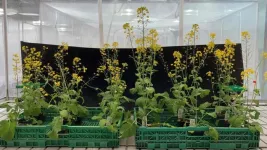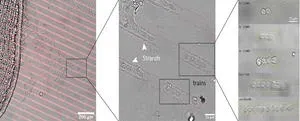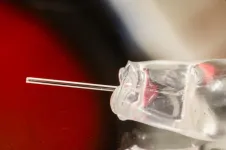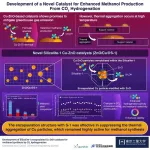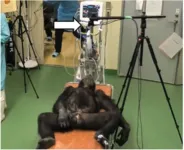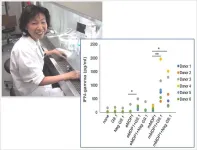(Press-News.org) A team of researchers at the University of Zurich has discovered that plants benefit from a greater variety of interactions with pollinators and herbivores. Plants that are pollinated by insects and have to defend themselves against herbivores have evolved to be better adapted to different types of soil.
Plants obtain nutrients and water from the soil. Since different soil types differ in their chemical and physical composition, plants need to adapt their physiology to optimize this process on different soil types.
This evolutionary process leads to the formation of ecotypes, i.e., locally adapted “plant breeds” that differ slightly in appearance and may no longer be easily crossbred. The latter effect is considered to be the first step toward the formation of separate species. The adaptation of crops to local soil types is also crucial for agricultural productivity.
Experiment with bumblebees and aphids
A team of researchers led by biologist Florian Schiestl of the Department of Systematic and Evolutionary Botany at the University of Zurich has now discovered that the interaction of plants with pollinators and herbivorous insects influences their adaptation to soil types and thus the formation of ecotypes. In a two-year experiment, about 800 swede plants were grown over 10 generations on different soil types in a greenhouse. One group was pollinated by bumblebees, another by hand; in addition, the plants were cultivated with and without aphids (as herbivores).
At the end of the evolutionary experiment, the researchers investigated the extent to which the plants on the two soil types differed in shape and composition and how well they had adapted to the soil. In terms of shape, it was found that only the plants pollinated by bumblebees showed clear differences between the soil types, while the hand-pollinated plant groups remained largely the same.
Plants pollinated by bumblebees adapt best
When it comes to adaptation to soil types, the researchers even found significant adaptation only in bumblebee-pollinated plants with aphids after the two years of experimental evolution, while no significant adaptation to soil types was observed in the other groups.
The study also identified several genes that may play a critical role in this adaptation process. The results show that biotic interactions can have a strong influence on plants’ ability to adapt to abiotic factors and that adaptation is most efficient when plants are exposed to a variety of interactions.
END
Interaction with insects accelerates plant evolution
2024-06-19
ELSE PRESS RELEASES FROM THIS DATE:
More effective cancer treatment with iontronic pump
2024-06-19
When low doses of cancer drugs are administered continuously near malignant brain tumours using so-called iontronic technology, cancer cell growth drastically decreases. Researchers at Linköping University, Sweden, and the Medical University of Graz, Austria, demonstrated this in experiments with bird embryos. The results, published in the Journal of Controlled Release, is one step closer to new types of effective treatments for severe cancer forms.
Malignant brain tumours often recur despite surgery and post-treatment with chemotherapy and radiation. This is because cancer cells can “hide” deep within tissue and then regrow. ...
Ultrasound beam triggers ‘nanodroplets' to deliver drugs at exactly the right spot
2024-06-19
Conventional drug delivery is often like cracking a nut with a sledgehammer. Whether the drug is swallowed, injected, inhaled, or absorbed through the skin, it ultimately diffuses to most parts of the body, including those where it isn’t needed – or where it even might cause harm.
But what if the delivery could be targeted at exactly the right spot? This would allow the total dose to be dramatically lower, thus minimizing side-effects.
Now, scientists from the US have found a way to perfect a promising, ...
Blessing in disguise: Mycoviruses enhance fungicide effectiveness against plant pathogens
2024-06-19
Osaka, Japan — As detrimental as viruses may sound, they can be helping hands for farmers when it comes to dealing with plant pathogens.
Osaka Metropolitan University scientists have discovered that a mycovirus that infects plant pathogenic oomycete Globisporangium ultimum can increase the latter’s sensitivity to specific fungicides. Their findings could lead to innovative approaches for controlling plant diseases, reducing reliance on chemical treatments, and minimizing agricultural loss.
Their results were published in Microbiological Research ...
A novel signal-amplification system utilizing sumanene-based supramolecular polymers
2024-06-19
Chemical sensors whose signals can be amplified by various triggers hold huge potential in multidisciplinary sciences. However, developing such systems was considered a highly challenging task, until a team of researchers from Tokyo Tech recently came up with a novel signal-amplification system that can be flexibly manipulated by a dynamic allosteric effector or a trigger. This new chemosensor system exhibited exception signal amplification by altering the sumanene monomer concentrations.
Synthetic supramolecular hosts and artificial receptors have found an exciting application in the form of chemical sensors or chemosensors, ...
Transforming inexpensive quinolines into complex drug candidates
2024-06-19
An innovative synthesis strategy opened up the way to 2D/3D fused frameworks using inexpensive quinolines as feedstock, report scientists from Tokyo Tech. By leveraging a light-sensitive borate intermediate, the scientists could transform quinoline derivatives into a great variety of 2D/3D fused frameworks in a straightforward and cost-effective manner. Their findings are expected to enable the synthesis of highly customizable drug candidates.
Quinolines have garnered much attention from chemists wanting to synthesize compounds known as 2D/3D fused frameworks. These complex organic molecules have a lot of medical potential due to their highly ...
Unlocking heart health: advancing noninvasive monitoring in chimpanzees
2024-06-19
Measuring the heart rate of great apes in captivity is essential for both health management and animal studies. However, existing most methods are either invasive or inaccurate. Now, researchers from Japan have investigated the potential of using millimeter-wave radar technology to estimate heart rate from subtle body movements in chimpanzees. Their efforts will hopefully pave the way to better practices and techniques for monitoring heart rates in wild and captive primates.
Just like in humans, heart rate is a critically important and informative vital sign in nonhuman primates. Heart diseases are among the main causes ...
Study uses powerful new ‘digital cohort’ method to understand vaping epidemic
2024-06-19
Tapping into the vast amount of data now available on social media, a new study from scientists at the University of California San Diego introduces a powerful new approach to understanding the nation’s health, in this case the vaping epidemic.
The study, published in the American Journal of Preventive Medicine on June 19, was led by John W. Ayers, Ph.D., from the Qualcomm Institute within UC San Diego.
“Researchers studying social media have tended to analyze the frequency and content of posts,” said Ayers, who is deputy director of informatics at the Altman Clinical and Translational Research Institute, vice chief of innovation in the Division of Infectious ...
A new tuberculosis vaccine candidate recombinant protein with additional post-translational modifications occurring in Mycobacterium tuberculosis cells
2024-06-19
Niigata, Japan - Tuberculosis is still one of the deadliest infectious diseases, causing over one million deaths each year worldwide. Additionally, about one-fourth of the world's population carries Mycobacterium tuberculosis (M. tuberculosis) without showing any symptoms, and most of these carriers do not develop the disease.
The current anti-tuberculosis vaccine, BCG, is administered worldwide. However, considering that more than 10 million new tuberculosis cases are reported each year, its effectiveness is deemed ...
Experts converge at USC Music, Health, and Policy workshop
2024-06-19
USC recently hosted its first Music, Health, and Policy workshop as part of Los Angeles County Arts and Health Week, filling Joyce J. Cammilleri Hall on the University Park Campus.
Event organizer Assal Habibi, an associate professor at the Brain and Creativity Institute at the USC Dornsife College of Letters, Arts and Sciences who explores the intersection between music and the human brain, brought together a wide range of experts on the importance of art and its effect on human development and well-being.
“The workshop aims to bring people together ...
Private school and/or ‘higher status’ university education linked to better mid-life health
2024-06-19
A private (fee-paying) school and/or a ‘higher status’ (Russell Group*) university education may be linked to better mid-life health—at least in the UK—suggests research published online in the Journal of Epidemiology & Community Health.
Alongside the level of education achieved, the type of educational institution a person attends may also influence subsequent health outcomes, suggest the researchers.
Published research to date indicates that educational attainment is associated with better subsequent health. But other aspects ...
